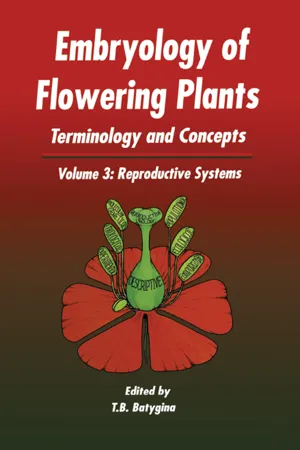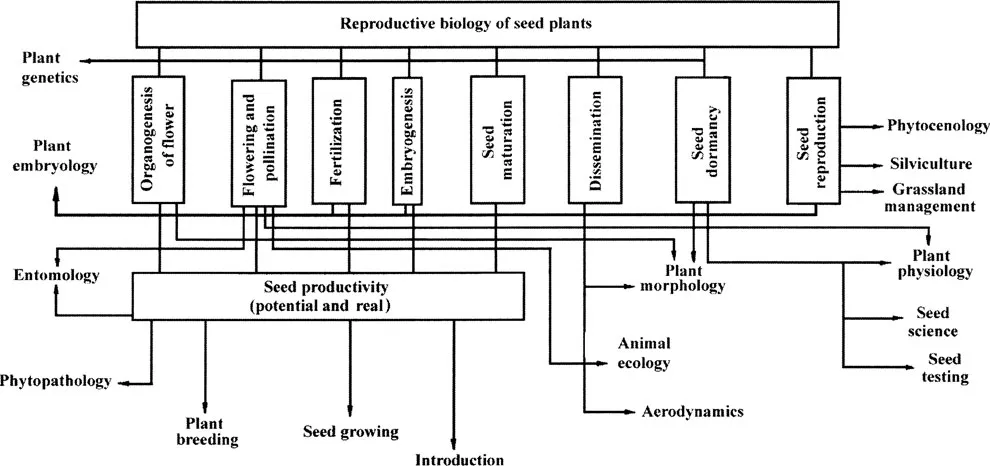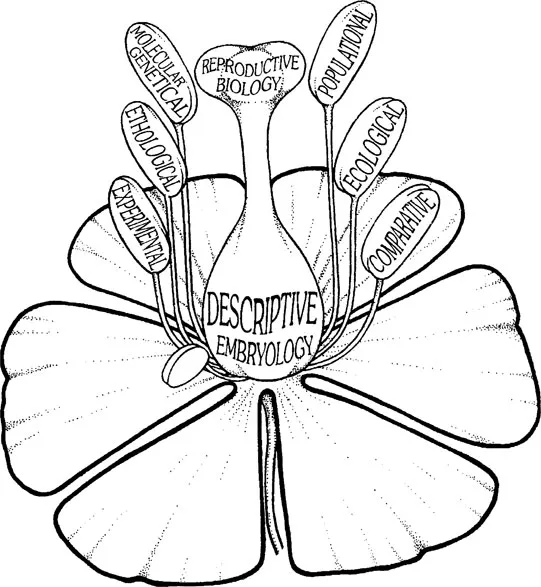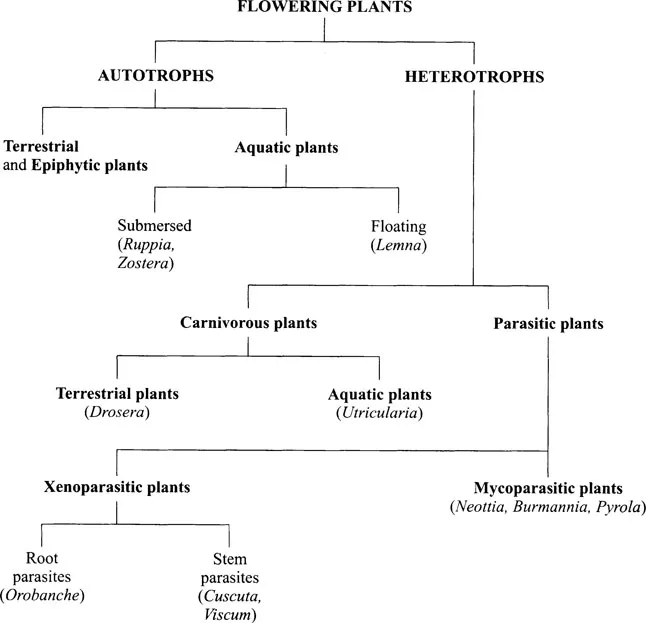![]() PART ONE–PLANT REPRODUCTION
PART ONE–PLANT REPRODUCTION![]()
OVERVIEW
Reproductive Biology
Reproductive processes have exceptional significance not only in regular renewal of plant cover, but also in restoration of the foundation of our existence — the diverse world of plants, which has been disturbed in consequence of the continuous rise in anthropogenic pressures. Hence, repeated attempts to draw the attention of scientists to the problems of reproduction, and especially seed propagation, are well justified.
Levina (1981) undertook one such attempt in her book Reproductive Biology of Seed Plants. Problem Review (Fig. 1). While highly appreciating this work and realizing its importance for the development of our knowledge on reproductive processes in plants and approaches to their investigation, we find that certain aspects of concepts that entered our scientific practice in the context of reproductive biology should now be critically evaluated. This needs to be done because the reproductive biology in Levina’s work is represented as a new synthetic approach to the study of reproductive cycles. The question that could and should be raised nowadays is whether the notion “reproductive biology” reflects a new scientific problem and consequently a new scientific approach, or whether it is only a more modern designation of a particular area of research in botany.
According to Levina, plant reproductive biology developed gradually from the direction of plant reproduction and propagation studies, which was earlier referred to as “biology of propagation”. She emphasized that reproductive biology is first of all distinguished by a larger volume of investigations, connected with various levels of study of propagation processes. The biology of propagation has been studied just at the organism level and has taken into consideration hereditary morphophysiological peculiarities of an organism, whereas reproductive biology is studied at the species level and reflects the dependence of propagation on the ecological situation.
Some remarks should be made here on the implication of the terms discussed probably need to be made here. Ponomarev (1969), examining the same subject, came to the conclusion that the traditional terms “biology of flowering” and “biology of flowering and pollination” should be abandoned as they did not clearly reflect the essence of the phenomenon. To his mind, the term “antecology” was more acceptable; it was more exact in meaning, more convenient to use, and more comprehensive, because it included both the ecology of the flower and the ecology of pollination. Here the ecology of the flower represents, as a matter of fact, its ecological morphology, elucidating different structures, mechanisms and peculiarities of flower development from the point of view of their significance in fulfilling functions inherent to a flower. Ponomarev uncovered a wide spectrum of approaches to the investigation of the flower and its functions within antecology. Biology has to be understood correctly as a science of living organisms as a whole, comprehending all their divisions, as was suggested by Heksli in his time.
Thus, from the position mentioned above, the expression “reproductive biology” seems to be preferable as the term for this particular research area, rather than the name of a new scientific approach, problem or direction. The perspective of the intact (here meaning complex) approach to the study of reproductive processes is undoubtedly attractive, since it gives essential addition of new knowledge. Nevertheless, this “addition of knowledge” implies, as could be understood, their widening and generalization rather than a new step to a deeper cognition of reproduction regularities.
Fig. 1: Interrelations of plant reproductive biology and the different branches of fundamental and applied sciences (modified from Levina, 1981).
Fig. 2: Principal directions of modern plant embryology.
Starshova (1989) appreciated the overall contribution of Levina to the elaboration of reproductive biology as a problem that lies, in her opinion, in the creation of a synthetic approach to the study of reproductive cycles. The general ideas of such an approach are as follows. The reproductive biology of species ought to be studied at the organism, population, species and biocoenocytic levels. What Levina and Starshova refer to as “levels” are from our point of view more probably “areas” of investigation or their methodical aspects. These “levels” of organization of living beings in themselves have no direct relation to the problem discussed. For example, antecology could be investigated only in coenocytic and population “areas” (correctly, in these aspects —E. Teryokhin), irrespective of whether such investigations are examined within reproductive biology or alongside it. On the other hand, embryology and carpology, depending on the tasks set, can be perfectly emcompassed by research at the organism level. So, from our point of view, this thesis does not testify a principally new approach to the study of reproduction.
The next idea is that “biology of seed propagation” and “reproductive biology” are different in terms of their controlling systems. The first applies to the organism level, for which the structural controlling system is characteristic. The second is a process occurring in systems above the organism level, by stochastic type of control. To our mind, stochasticity is associated with individual and population level, as well as with the “structural” controlling system. The question arises only in their ratio in any “area”.
Reproductive biology (correctly, the reproductive processes —E.T.) plays a vital role in the struggle for species preservation. It is characterized by large quantitative reserves and ecological plasticity of certain stages. One cannot but agree with this thesis. However, it contains nothing that confirms the need to divide reproductive biology (but not the study of reproductive processes —E.T.) into specific scientific problems.
In this connection, the statement that reproductive biology, believed to be a specific intact and complex problem, requires collective elaboration according to single methods is also vulnerable to criticism.
In our opinion, the investigation of concrete peculiarities of reproductive processes in various taxa and ecologically differentiated groups of plants in all levels of their organization indeed proves to be the scientific problem (Salisbury, 1942; Teryokhin, 1988, 1997). The integrity of scientific notions about any reproductive cycle is gradually being proved, as a consequence of the analysis of concrete results of investigation. With such an approach, the “collective elaboration according to single methods” is not required. This requirement is probably more suitable to experimental research in biotechnology than to the investigation of the specifics of reproduction in natural conditions.
In the above context, the importance of ecologization of investigation in the field of plant reproduction cannot escape attention.
I venture to claim that notions on ecology by Levina (1981), consonant enough to the time in which her book was being written, currently seem to be rather one-sided. As can be seen from the context of the book, she adopts the notion of ecology, including the ecology of reproduction, as the diverse influences of biotic and abiotic factors on the reproductive process.
In this regard, a comparison of Levina’s work with Willson’s Plant Reproductive Ecology (1983) is quite pertinent. There are considerable distinctions between the contents of the two works, especially the approaches to the same structures and processes and the analysis of interacting phenomena and factors.
Thus, there exist two different approaches to the investigation of reproductive cycles. All this does not mean that Willson’s views on reproductive processes are preferable to Levina’s. They are simply different. To our mind, Willson’s ecological interpretations are distinguished by a superfluously “economized” approach to the analysis of reproduction phenomena. It is quite competent but probably not adequate. Deeper reflection on the role and significance of plant behaviour in the reproductive cycle is necessary.
In this connection, one cannot but cite the statement of Faegri and van der Pijl (1966) from their book The Principles of Pollination Ecology in reference to the investigation of a flower. In their view, the flower structure should be contemplated from the perspective of pollination ecology, i.e., as a functional unit. Otherwise, the flower morphology loses all meaning and the development of the flower itself and its elements becomes unclear and can be interpreted only from the position of orthogenesis or similar theoretical concepts. On the problem of adaptative significance of reproductive processes, some authors remark that it would be extremely imprudent to assume that most exact and complicated relations between animals and plants observed during pollination have arisen accidentally, as a result of indirect variability. The adaptive capacity of an organ cannot be denied just because we do not know its functions.
In this way, the scientific community has already answered the question whether the reproductive biology of plants is the division of botany involving detailed investigation of reproductive processes or a specific scientific problem. It answered this question in the form of such new concrete research directions as antecology (Faegri and van der Pijl, 1966; Ponomarev, 1969), ecological carpology (van der Pijl, 1969) and ecological embryology (Teryokhin, 1977, 1988, 1997). In the last few years, in connection with the rapid development of new ideas and methods in the sphere of developmental genetics and biotechnology, such new directions of reproductive biology as investigation of fine mechanisms of pollination (the problem of selfincompatibility), genetic control of flower formation, genetic engineering of gametes and embryos, genetic control of apomixis and genetic control of the development of hybrid seeds have emerged and are rapidly progressing.
These directions, presented in the third volume, reflect current problems and new approaches in the sphere of reproductive biology of plants.
New discoveries in the area of reproductive biology of plants and their practical value are hard to foresee, but even those that have been achieved strike the imagination.
Ecological Embryology
Ecological embryology is the division of embryology comprising investigation of causative interactions between environmental factors, plant behaviour and adaptive peculiarities of organization of generative and embryonal structures. By definition, this sphere of research appears to be part of evolutionary botany. Ecological causal approach to embryological investigations is essentially close to the causal-functional analysis in carpology (Pijl van der, 1969), anthecology (Faegri and van der Pijl, 1980), but it has other trends in the study of ecological functions, as well as in the spectrum of structures investigated.
Ecological embryology is just beginning to develop, and that sets certain limits in the choice of subjects for study. Such subjects must be ecologically distinct, amenable to accurate and detailed ecological analysis, and perfectly studied morphologically.
The following groups of angiosperms correspond to these criteria: plantxenoparasites with different modes of nutrition (Scrophulariaceae - subfamilies Orobanchoideae and Rhinanthoideae, Balanophoraceae, Cuscutaceae, Hydnoraceae, Loranthaceae, Rafflesiaceae, Viscaceae), mycoparasitic plants (Ericaceae — subfamilies Monotropoideae and Pyroloideae, Burmanniaceae, Orchidaceae, some genera of the Gentianaceae) and also predatory plants, including water plants (Droseraceae and Lentibulariaceae). Some taxa of submersed plants (Potamogetonaceae, Ruppiaceae, Zosteraceae) also meet those criteria (Fig. 3).
Fig. 3: General modes of flowering plant nutrition (after Teryokhin, 1977).
The theoretical basis of ecological embryology consists of the following concepts. The first is the adaptive character of evolutionary modifications of ontogenesis. We extend the concept of adaptive modifications directly to the processes of macroevolution as well, referring to the mechanisms of such modifications in relation to the concept of “new synthesis” (Gilbert et al., 1996). The second is the acceptance of evolutionary priority and guiding role of ecological functions with regard to evolutionary structural modifications. Herewith we understand the ecology in the same way as Lemée (1967) did. According to his notions, the investigation of connections between environmental factors and organisms has two aspects: (1) the study of the character of the environment in which organisms are living, mesological ecology or mesology, and (2) the research of behaviour and reaction of organisms in this environment, etological ecology or etology. We consider the reactions of organisms to mesological influences to form the definite complexes that are referred to as behaviour (e.g., nutritive or reproductive behaviour), depending on aims of directional activity. Behaviour is inherent to all types of organisms, including plants (Teryokhin, 1972, 1977).
Behaviour plays, in our opinion, a specific role in the evolution of ontogenesis, as far as it is behavioural changes that direct evolutionary modifications of structures (Teryokhin, 1991). Stress being a trigger factor is a very productive concept when discussing behavioural changes and appropriate structural modifications. It could be proposed that stresses, particularly “ecological” stresses (i.e., stresses caused by mesological factors) are effective trigger mechanisms of evolution, especially in the processes of ecological niche shifting, e.g., during the transition from autotrophic to parasitic (heterotrophic) mode of nutrition (Teryokhin, 1996).
Interaction of ecological (mesological and etological) factors can be followed on the example of adaptive evolution of certain ecologically distinct groups of flowering plants.
The ecological niche of members of the subfamily Rhinanthoideae (Scrophulariaceae) is “root” parasitism, i.e., parasitism on the roots of suitable host plants, usually monocots (Fig. 4). This subfamily is especially interesting due to the fact that it includes species and genera with different degrees of specialization in root parasitism: from facultative parasites (Euphrasia minima, Melampyrum lineare) up to highly specialized achlorophyllous parasites (Harveya coccinea, Hyobanche sanguinea, Striga gesnerioides). The degree of specialization of these plants in...



